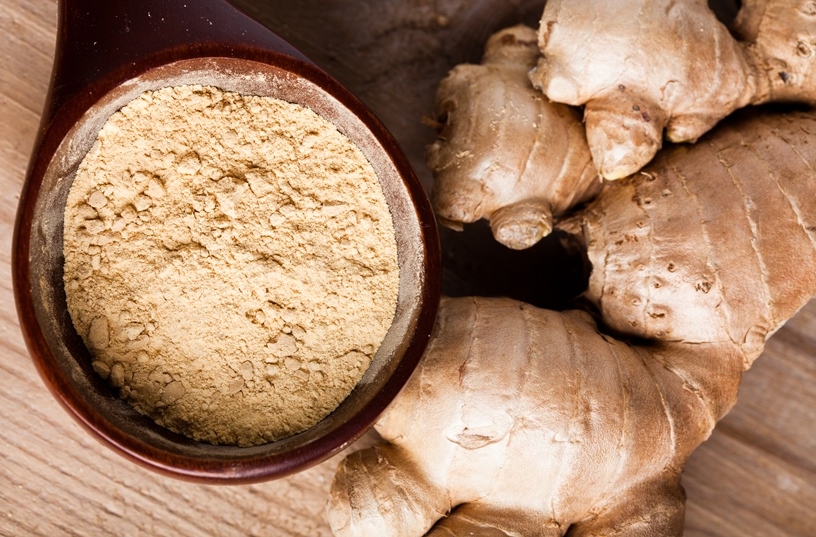Ginger belongs to the Zingiberaceae family. It is mainly the main underground shoot of ginger – the ginger rhizome – which is important for us. These rhizomes are what is commonly referred to as “ginger root”. The ginger plant originates in the warm and humid tropics of Central and South-East Asia where, for thousands of years, it has been regarded as a medicinal plant. Naturopathic uses of ginger range from treatment of colds, rheumatism, gingivitis and diabetes through to gastrointestinal problems such as flatulence, colic, cramps and loss of appetite [1].
It is believed that the Romans brought this plant to Europe. In the Middle Ages people enjoyed it as gingerbread and poorer people used it as a substitute for pepper [2].
Health and nutrition
The characteristic spiciness of ginger is thanks to its aromatic pungent constituent gingerol. Ginger root is also rich in the pungent constituent shogaol and many essential oils. These are very volatile, however, so ginger should always be used in as fresh a state as possible [3].
As a spice, ginger promotes digestion and, on account of its pungent constituents, also stimulates the metabolism. A cup of fresh ginger tea before eating stimulates saliva production and secretion of digestive juices and is therefore highly recommended, provided you enjoy the spicy taste. Traditionally, also in the form of tea, ginger can help alleviate gastrointestinal problems and nausea. In initial clinical studies consumption of ginger during chemotherapy led to a reduction in nausea if taken prior to commencement of chemotherapy. Nausea and vomiting are amongst the most common side effects of chemotherapy. Potential consequences are malnutrition and physical complications such as a disturbance of the acid-base or electrolyte level balance, which, in turn, can negatively impact on the success of chemotherapy [4, 5].
Fresh ginger in particular also seems to have an antioxidant and anti-inflammatory effect. It helps in protection against colds, chronic conditions and can also contribute to a reduction in muscle pain after intensive physical activity. A number of new studies report on the potential cancer-preventive properties of ginger with regard to breast and colorectal cancer [6]. The constituents gingerol, shogaol and paradol appear to be involved in this protective effect. Concentrations of these constituents can fluctuate a great deal depending on the origin of the ginger as well as how it is stored and prepared. The potential positive effects of ginger for cardiovascular diseases and diabetes mellitus are also under discussion [7].
There are a few medicines which develop an interaction with the constituents of ginger. For this reason, always read the patient information leaflet carefully to find out about such interactions if ginger is taken at the same time. In rare cases increased consumption of ginger led to heartburn, flatulence and nausea [2, 7].
In the kitchen
The quality of ginger root can be recognised easily based on its appearance: if the skin is light and smooth, the flesh is also firm and succulent. Fresh ginger develops a flavoursome spiciness with a subtly sweet hint of lemon.
Freshly grated or ground ginger is a popular spice in Asian cuisine. It is ideal in rice dishes, curries, meat dishes as well as pumpkin soup; it tastes delicious sprinkled over salads or pickled in vinegar and served with sushi. Depending on the taste required, ginger can first be added at the end of the cooking time in order to preserve its fruity flavour. Alternatively, it can be added from the beginning of the cooking time to intensify spiciness.
Ginger is also a very popular ingredient for desserts. In traditional English cuisine it is used in gingerbread and ginger biscuit, as well as preserved fruits and ginger confiture to be enjoyed with afternoon tea. In Germany ginger has increased in popularity recently and, over the last few years, has featured in ice cream, smoothies and soft drinks. Appetising chocolate-covered ginger sticks have also become widespread.
Ginger can also be enjoyed as a drink, in the form of fresh ginger tea or ginger water. It is easy to prepare – simply place slices of ginger into water, or pour hot water over the ginger, allow to steep and then drink either hot or cold. The amount of ginger used can be varied according to individual taste and this also means the spiciness can be controlled.
At home, store this versatile ingredient in a vegetable drawer or in a cool, dry place [2].
Practical tip: Have a go at making the pumpkin and ginger soup by Michelin-star chef Hans Haas. The warming spice of this dish makes it especially delectable when the weather is cold.
